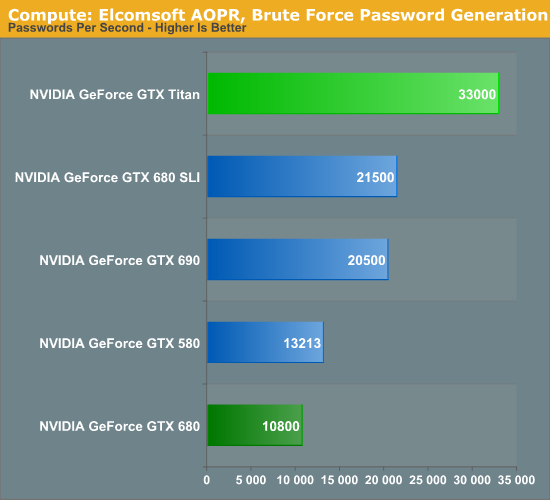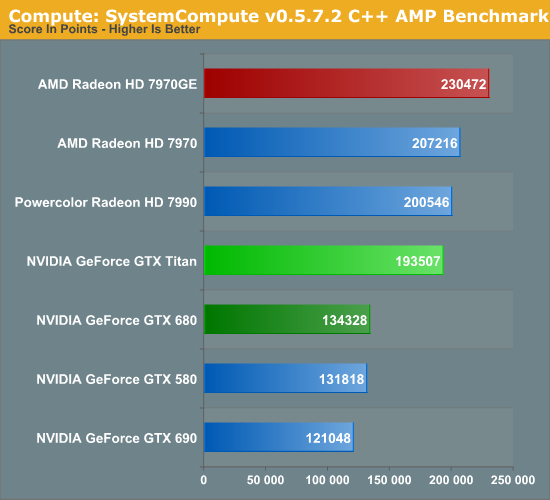NVIDIA’s GeForce GTX Titan Review, Part 2: Titan's Performance Unveiled
by Ryan Smith & Rahul Garg on February 21, 2013 9:00 AM ESTTitan’s Compute Performance, Cont
With Rahul having covered the basis of Titan’s strong compute performance, let’s shift gears a bit and take a look at real world usage.
On top of Rahul’s work with Titan, as part of our 2013 GPU benchmark suite we put together a larger number of compute benchmarks to try to cover real world usage, including the old standards of gaming usage (Civilization V) and ray tracing (LuxMark), along with several new tests. Unfortunately that got cut short when we discovered that OpenCL support is currently broken in the press drivers, which prevents us from using several of our tests. We still have our CUDA and DirectCompute benchmarks to look at, but a full look at Titan’s compute performance on our 2013 GPU benchmark suite will have to wait for another day.
For their part, NVIDIA of course already has OpenCL working on GK110 with Tesla. The issue is that somewhere between that and bringing up GK110 for Titan by integrating it into NVIDIA’s mainline GeForce drivers – specifically the new R314 branch – OpenCL support was broken. As a result we expect this will be fixed in short order, but it’s not something NVIDIA checked for ahead of the press launch of Titan, and it’s not something they could fix in time for today’s article.
Unfortunately this means that comparisons with Tahiti will be few and far between for now. Most significant cross-platform compute programs are OpenCL based rather than DirectCompute, so short of games and a couple other cases such as Ian’s C++ AMP benchmark, we don’t have too many cross-platform benchmarks to look at. With that out of the way, let’s dive into our condensed collection of compute benchmarks.
We’ll once more start with our DirectCompute game example, Civilization V, which uses DirectCompute to decompress textures on the fly. Civ V includes a sub-benchmark that exclusively tests the speed of their texture decompression algorithm by repeatedly decompressing the textures required for one of the game’s leader scenes. While DirectCompute is used in many games, this is one of the only games with a benchmark that can isolate the use of DirectCompute and its resulting performance.
Note that for 2013 we have changed the benchmark a bit, moving from using a single leader to using all of the leaders. As a result the reported numbers are higher, but they’re also not going to be comparable with this benchmark’s use from our 2012 datasets.

With Civilization V having launched in 2010, graphics cards have become significantly more powerful since then, far outpacing growth in the CPUs that feed them. As a result we’ve rather quickly drifted from being GPU bottlenecked to being CPU bottlenecked, as we see both in our Civ V game benchmarks and our DirectCompute benchmarks. For high-end GPUs the performance difference is rather minor; the gap between GTX 680 and Titan for example is 45fps, or just less than 10%. Still, it’s at least enough to get Titan past the 7970GE in this case.
Our second test is one of our new tests, utilizing Elcomsoft’s Advanced Office Password Recovery utility to take a look at GPU password generation. AOPR has separate CUDA and OpenCL kernels for NVIDIA and AMD cards respectively, which means it doesn’t follow the same code path on all GPUs but it is using an optimal path for each GPU it can handle. Unfortunately we’re having trouble getting it to recognize AMD 7900 series cards in this build, so we only have CUDA cards for the time being.

Password generation and other forms of brute force crypto is an area where the GTX 680 is particularly weak, thanks to the various compute aspects that have been stripped out in the name of efficiency. As a result it ends up below even the GTX 580 in these benchmarks, never mind AMD’s GCN cards. But with Titan/GK110 offering NVIDIA’s full compute performance, it rips through this task. In fact it more than doubles performance from both the GTX 680 and the GTX 580, indicating that the huge performance gains we’re seeing are coming from not just the additional function units, but from architectural optimizations and new instructions that improve overall efficiency and reduce the number of cycles needed to complete work on a password.
Altogether at 33K passwords/second Titan is not just faster than GTX 680, but it’s faster than GTX 690 and GTX 680 SLI, making this a test where one big GPU (and its full compute performance) is better than two smaller GPUs. It will be interesting to see where the 7970 GHz Edition and other Tahiti cards place in this test once we can get them up and running.
Our final test in our abbreviated compute benchmark suite is our very own Dr. Ian Cutress’s SystemCompute benchmark, which is a collection of several different fundamental compute algorithms. Rahul went into greater detail on this back in his look at Titan’s compute performance, but I wanted to go over it again quickly with the full lineup of cards we’ve tested.

Surprisingly, for all of its performance gains relative to GTX 680, Titan still falls notably behind the 7970GE here. Given Titan’s theoretical performance and the fundamental nature of this test we would have expected it to do better. But without additional cross-platform tests it’s hard to say whether this is something where AMD’s GCN architecture continues to shine over Kepler, or if perhaps it’s a weakness in NVIDIA’s current DirectCompute implementation for GK110. Time will tell on this one, but in the meantime this is the first solid sign that Tahiti may be more of a match for GK110 than it’s typically given credit for.










337 Comments
View All Comments
Alucard291 - Friday, March 8, 2013 - link
And once again you spew your b/s out of every orifice.But you still haven't said why you think your walls of nonsense make any difference :)
To 4chan with ya
CeriseCogburn - Sunday, February 24, 2013 - link
You people literally are pathetic. Right now, the cheapest gtx 670 is $720 sli, right ?Get your sli motherboard, get ready for extra heat, a better PS ( already stated botiques are launching these with 450W PS.
So how many months after 670 launch with reduced prices are you only 25% off the single fastest video card in the world, while you take the cheapest version you can find ?
You people are seriously filling your diapers at an unbelievable rate.
I'll note once again for all you fools who continuously missed it, and still do, because of course, your gigantic flapping lips wraped around the gourd so many times they sealed off oxygen flow to the brain that you not only don't want to face reality, but choose not to on purpose:
There was a manufacturing shortage for die space in Jan 2012 when 79xx did a near paper launch. Availability for that card was short till a day before the small in comparison 680 die hit the shelves far over half a year later, and the SINGLE factory in the entire world for production was busily building out well over 2 BILLION in emergency production space desperately trying to keep up with bare minimum demands.
THERE WAS NO CAPACITY to produce a 7.1B transistor chip. The design of the chips follows a very slow SEVERAL YEAR slog, and even now, yield on the most complex chip ever is no doubt too low for comfort, and far too low to have been "launched" WHEN YOU IDIOT TIN FOIL HAT WEARING CHARLIE D BUTT KISSING MIND SLAVE FOOLS claim the conspiracy against all gamers was undertaken by "the greedy nVidia".
You people suck.
ronin22 - Thursday, February 21, 2013 - link
Common, stupid..If you are expecting a gaming card, go buy your AMD whatever.
The real magic of Titan is its compute power.
You were stupid to expect anything else from a GK110
CeriseCogburn - Saturday, February 23, 2013 - link
Good to know amd absolutely failed to produce a top end videocard and has stuck all you tards with their only release, a mid range, at $579+ in comparison.
Be a mid ranger, buy amds flagship, the half mast loser card mid range.
piiman - Saturday, February 23, 2013 - link
Come on it's priced , for now, for the Geeks that have to have the biggest most bad ass card out. It will come down once those suckers...oops I mean enthusiast are sucked dry. :-)CeriseCogburn - Saturday, February 23, 2013 - link
Since amd is a sucked dry shriveling corpse (excellent fanboy mistreatment by the tightwad whining poorboy amd penny pinching freaks), your theory, if we give a single deformed brain cell of credit to the amd fanboys, when they wail without amd everything will be a thousand bucks, may not pan out.AMD is dying, and when gone, a thousand bucks will be standard, right all you amd fanboys ?
Start getting used to it.
L O L
atlr - Thursday, February 21, 2013 - link
Agreed. I was hoping for an initial price somewhat proportional to the performance like US$700. Perhaps ebay will be flooded with enough 680's and 690's from the early 'ticket' buyers which will cause retail prices of the same to drop.wongwarren - Thursday, February 21, 2013 - link
Guess you guys didn't read the article properly:With a price of $999 Titan is decided out of the price/performance race; Titan will be a luxury product, geared towards a mix of low-end compute customers and ultra-enthusiasts who can justify buying a luxury product to get their hands on a GK110 video card.
Alucard291 - Thursday, February 21, 2013 - link
Wait wait wait, a GPU is now a luxury product?There was me thinking that all pc components have long since become commodities...
JeffFlanagan - Thursday, February 21, 2013 - link
I agree that talk of a luxury GPU seems odd. Is there any game that will actually look better with this card rather than a $400 card?It may allow the user to up the resolution, but is anyone even shipping textures with detail beyond 1080p these days?
I haven't bought a video card in several years, and can still select Ultra settings on new games at 1080p.